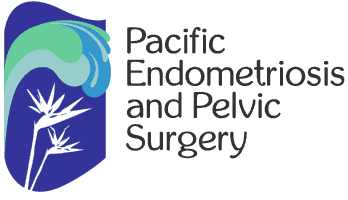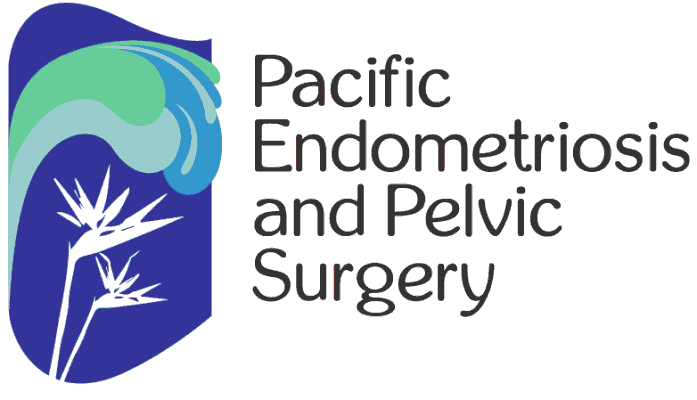One of the most painful manifestations of Deeply Infiltrating Endometriosis is that involving the gastrointestinal tract, or the bowels. We don’t know the exact proportion of women with endo who have bowel disease, but in specialized practices it can be up to 30% of endometriosis patients. Intestinal endometriosis can cause a variety of symptoms depending on where on the bowel it is (small bowel, colon, appendix, etc). The most common site on the bowel is the rectosigmoid colon – the part of the colon that lies right behind the cervix and upper vagina, between the uterosacral ligaments. Endometriosis here is commonly associated with “stage IV” disease – where there are endometriomas in one or both ovaries, and the ovaries, colon, and cervix/uterus are all stuck together with endometriosis causing these adhesions. Ironically, while some patients can have minimal symptoms (“I just thought I had bad cramps”), most of the time these rectal nodules will cause significant pain with defecation as well as alternating constipation and diarrhea, hesitancy (being unconsciously afraid to have a BM), urgency (gotta go NOW!), and some patients will actually pass out after passing a stool. Most (95%) endo of the colon does not infiltrate the mucosal lining, meaning it can’t be seen on colonoscopy, so it is rarely recognized by gastroenterologists.
Symptoms
Symptoms of endo within the muscle layer of the rectosigmoid colon are usually sharp pain either during the actual bowel movement, or just before as the mostly solid stool is pushed through the segment of colon with the endo in it. As is shown in the ultrasound image at right, the nodule almost always causes both narrowing of the lumen (stricture) as well as a sharp kink in the colon, both of which explain symptoms of increasing pain and bloating until the stool passes by the nodule, then relief that can be immediate. Patients have described the pain during these episodes as feeling like “a steak knife” or “shards of glass”, along with severe “gut cramps” from intense contraction of the colon trying to push the stool through the narrowed length of colon. There can also be nausea and vomiting during these episodes.
Most endo lesions on the rectosigmoid are not as large or as deep as those described above and live mostly in the serosa and outer muscularis. These lesions will typically cause pain with BMs mostly during or just before menses, and while it can be sharp pain, they don’t usually cause the kinking or strictures, thus they cause less of the bloating and “gut cramps”.
Lesions on the small bowel are almost always in the terminal ileum, or the 2-3 feet of small bowel just before it dumps into the right colon. The appendix is also a common site of endo. Both small bowel and appendiceal endo tend to cause mostly nausea, bloating, diffuse GI cramping, and sometimes vomiting. Larger lesions on the ileum can cause obstructions requiring acute surgical intervention for vomiting that won’t stop. I have had several patients who underwent bowel resection of the ileal lesion by a general surgeon who told them afterwards “your pelvis was a mess but we didn’t want to touch it”.
Diagnosis
Diagnosis requires a high index of suspicion, and in the case of small bowel and appendiceal lesions sometimes cannot be made prior to surgery. Therefore, it is important to have a bowel surgeon on standby in patients in whom these lesions are suspected.
For lesions on the colon, especially the distal sigmoid and rectum, I find ultrasound to be the most reliable. The biggest limitation of ultrasond is that it will only image the distal 20 cm of the colon, and lesions above that will be missed. For higher lesions on the sigmoid, the right colon, and small bowel then MRI is more accurate. Please see my lecture for more detail and references.
Because of the reliability of ultrasound for imaging endo of the rectosigmoid colon, as well as the convenience for patients, we have obtained a state of the art 3D ultrasound specifically to image bowel lesions. It should improve our diagnostic capabilities and allow for improved preop planning.
Treatment
Treatment of intestinal endometriosis almost always involves surgery as medical management has been shown to be ineffective on these specific lesions. Fortunately, most bowel disease can be removed via a partial thickness bowel resection. What this means is that for lesions that are contained in the outer muscularis, they can be shaved off the bowel usually without entry into the lumen of the colon and the defect in the outer muscle layer is sutured closed. This dramatically lessens both recovery time as well as risk of infection and other complications, and hospital stay is usually not longer than for those without bowel surgery. Deeper lesions with diameters less than 2cm can usually be removed without a full bowel resection and anastomosis, although they sometimes require a full thickness incision into the lumen of the bowel. For these patients, I will usually watch them for a couple of days in the hospital to ensure that the bowels are working correctly. For larger lesions that cause kinking of the colon, involve more of the circumference of the colon, or are complicated for some other reason, these will require a segmental bowel resection with anastomosis, done by a general surgeon with whom I work frequently. This type of resection does require a longer hospital stay of 5-7 days usually, but can almost always be done without requiring a diverting ileostomy or colostomy.
Endometriosis of the appendix can be dealt with by an appendectomy that also doesn’t require an overnight hospital stay. Small bowel lesions can sometimes be shaved off and repaired, but because the bowel lumen is so much smaller than the colon, a higher percentage of small bowel lesions will require anastomosis with about a 3-4 day hospital stay.

